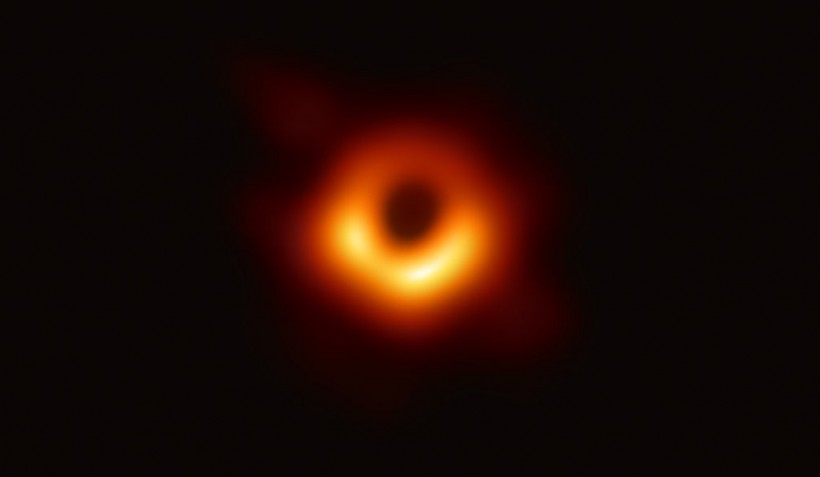Researchers at Imperial College London have successfully generated spinning superheating rings of plasma discs in a laboratory setting, resembling the accretion disks observed around black holes and forming stars.
This experiment reported in the study, titled "Differentially Rotating, Free-Boundary Laboratory Plasmas" published in Physical Review Letters, provides a more precise representation of the dynamics within these plasma discs, offering valuable insights into the growth of black holes and the formation of stars from collapsing matter.

In this handout photo provided by the National Science Foundation, the Event Horizon Telescope captures a black hole at the center of galaxy M87, outlined by emission from hot gas swirling around it under the influence of strong gravity near its event horizon, in an image released on April 10, 2019.
Accelerating Rings of Plasma
Dr. Vicente Valenzuela-Villaseca, the first author of the study conducted during his Ph.D., at Imperial College London's Department of Physics, emphasized the significance of understanding the behavior of accretion discs.
He said in the news release that this understanding not only helps unveil the growth of black holes but also sheds light on the collapse of gas clouds leading to star formation. Furthermore, it can contribute to enhancing our ability to create stars through improved comprehension of plasma stability in fusion experiments.
To conduct the experiment, the team utilized the university's Mega Ampere Generator for Plasma Implosion Experiments (MAGPIE) machine to accelerate and collide eight plasma jets, resulting in the formation of a rotating column. They observed that the inner region of the spinning ring moved faster, a crucial characteristic found in accretion discs in the universe.
Due to the short pulses of plasma generated by MAGPIE, the number of rotations achieved was limited to around one rotation of the disc. Nonetheless, this proof-of-concept experiment demonstrates the potential for increasing the number of rotations by using longer pulses, enabling a more comprehensive understanding of the disc's properties.
Extending the duration of the experiment would also allow the application of magnetic fields to examine their impact on the system's friction.
Dr. Valenzuela-Villaseca highlighted that this research marks just the beginning of exploring accretion discs in novel ways, combining experiments like theirs with observations from the Event Horizon Telescope that capture snapshots of black holes. These combined efforts will enable the testing of theories against astronomical observations.
READ ALSO: Black Holes Burp Like Babies While Eating Nearby Stars, Gas; Does It Affect Their Sizes?
What Are the Accretion Disks of Black Holes
According to Live Science, an accretion disk refers to a circular region of ionized gas, known as superheated plasma, that revolves around the event horizon of a black hole. The event horizon signifies the boundary from which nothing, including light, can escape.
The high-speed rotation of the disk generates centrifugal force, countering the gravitational pull of the black hole and maintaining the plasma's stable orbit. This plasma consists of matter drawn towards the black hole's boundary, which then undergoes extreme heating due to the intense gravitational forces.
The presence of an accretion disk has been indirectly observed through the detection of a blurred orange light halo surrounding M87*, a colossal black hole situated at the core of the Messier 87 galaxy.
Valenzuela-Villaseca highlights in their study that comprehending the behavior of accretion disks holds significance not only for understanding black hole growth but also for unraveling the process of gas cloud collapse leading to star formation. Additionally, future experiments involving accretion disk proxies could contribute insights into enhancing nuclear fusion reactors on Earth.
These accretion disk models could also serve as valuable references for researchers analyzing black hole data collected by the Event Horizon Telescope, a network of large radio dishes dedicated to studying supermassive black holes in the Milky Way and neighboring galaxies.
RELATED ARTICLE: NASA-Italian Space Agency IXPE Shows How Black Holes Swallow and Spit Out Celestial Matters
Check out more news and information on Space in Science Times.


![Humans Will Go Extinct on Earth in 250 Million Years; Mass Extinction Will Occur Sooner if Burning Fossil Fuels Continues [Study]](https://1721181113.rsc.cdn77.org/data/thumbs/full/53373/89/56/50/40/humans-will-go-extinct-on-earth-in-250-million-years-mass-extinction-will-occur-sooner-if-burning-fossil-fuels-continues-study.jpeg)











